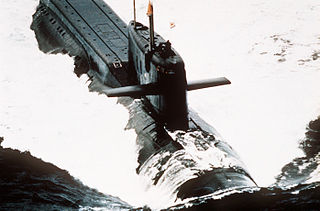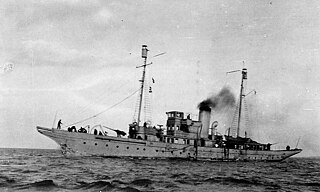
K-141 Kursk was an Oscar II-class nuclear-powered cruise missile submarine of the Russian Navy.

K-219 was a Project 667A Navaga-class ballistic missile submarine of the Soviet Navy. It carried 16 R-27U liquid-fuel missiles powered by UDMH with nitrogen tetroxide (NTO), and equipped with either 32 or 48 nuclear warheads.

K-19 was the first submarine of the Project 658 class, the first generation of Soviet nuclear submarines equipped with nuclear ballistic missiles, specifically the R-13 SLBM. The boat was hastily built by the Soviets in response to United States' developments in nuclear submarines as part of the arms race. Before it was launched, 10 civilian workers and a sailor died due to accidents and fires. After it was commissioned, it had multiple breakdowns and accidents, several of which threatened to sink the submarine.

HMS Triton was a submarine of the Royal Navy named for the son of Poseidon and Amphitrite, the personification of the roaring waters. She was the lead ship of the T class of diesel-electric submarines. Her keel was laid down on 28 August 1936 by Vickers Armstrong at Barrow-in-Furness. She was launched on 5 October 1937, and commissioned on 9 November 1938 with Lieutenant Commander H. P. de C. Steel in command.

USS Augusta (SSN-710), a Los Angeles-class submarine, was the first ship of the United States Navy to be named for Augusta, Maine. The contract to build her was awarded to the Electric Boat Division of General Dynamics Corporation in Groton, Connecticut on 31 October 1973 and her keel was laid down on 1 April 1983. She was launched on 21 January 1984 sponsored by Mrs. Diana D. Cohen, wife of U.S. Senator William Cohen and commissioned on 19 January 1985.

The Yankee class, Soviet designations Project 667A Navaga (navaga) and Project 667AU Nalim (burbot), was a series of nuclear-powered ballistic missile submarines built in the Soviet Union for the Soviet Navy. In total, 34 units were produced out of 24 built in Severodvinsk for the Northern Fleet and the remaining 10 in Komsomolsk-on-Amur for the Pacific Fleet. Two Northern Fleet units were later transferred to the Pacific. The lead boat K-137 Leninets received its honorific name on 11 April 1970, two and one half years after being commissioned.

The Victor class, Soviet designations Project 671 Yorsh, Project 671RT Syomga and Project 671RTM/RTMK Shchuka,, are series of nuclear-powered attack submarines built in the Soviet Union and operated by the Soviet Navy. Since the 1960s, 48 units were built in total, of which the last remaining units are currently in service with the Russian Navy. The Victor-class submarines featured a teardrop shape, which allowed them to travel at high speed. These vessels were primarily designed to protect Soviet surface fleets and to attack American ballistic missile submarines. Project 671 begun in 1959 and design task was assigned to SKB-143, one of the two predecessors of the Malachite Central Design Bureau, which would eventually become one of the three Soviet/Russian submarine design centers, along with Rubin Design Bureau and Lazurit Central Design Bureau.

A nuclear submarine is a submarine powered by a nuclear reactor. The performance advantages of nuclear submarines over "conventional" submarines are considerable. Nuclear propulsion, being completely independent of air, frees the submarine from the need to surface frequently, as is necessary for conventional submarines. The large amount of power generated by a nuclear reactor allows nuclear submarines to operate at high speed for long periods of time; and the long interval between refuelings grants a range virtually unlimited, making the only limits on voyage times being imposed by such factors as the need to restock food or other consumables.
K-131 was a Project 675 of the Soviet Navy's Northern Fleet, she was also redesignated K-192.

The Echo class were nuclear cruise missile submarines of the Soviet Navy built during the 1960s. Their Soviet designation was Project 659 for the first five vessels, and Project 675 for the following twenty-nine. Their NATO reporting names were Echo I and Echo II. All were decommissioned by 1994.

Whiskey-class submarines are a class of diesel-electric attack submarines that the Soviet Union built in the early Cold War period.
K-279 was the first Project 667B Murena ballistic missile submarine of the Soviet Navy. Development of Project 667B began in 1965. Her keel was laid down in 1971 by Sevmash at the Severodvinsk shipyard. She was launched in January 1972, and commissioned in the Soviet Northern Fleet on 22 December 1972.

Hostile Waters is a British 1997 television film about the loss of the Soviet Navy's K-219, a Yankee I class nuclear ballistic missile sub. The film stars Rutger Hauer as the commander of K-219 and claims to be based on the true story, also described in the 1997 book of the same name. The film was produced by World Productions for the BBC and HBO, in association with Invision Productions and UFA Filmproduktions. It was written by Troy Kennedy Martin and directed by David Drury, and was first transmitted on BBC One on 26 July 1997.

K-33 was a Soviet nuclear-powered Project 658-class submarine. She belonged to the Soviet Northern Fleet and carried the identification number 921. In 1977, she was renamed K-54.

HMS Tiptoe was a British submarine of the third group of the T class. She was built by Vickers Armstrong, Barrow, and launched on 25 February 1944. She was one of two submarines named by Winston Churchill, and so far has been the only ship of the Royal Navy to be named Tiptoe. In 1955 she was involved in a collision with a coastal steamer whilst in Tromsø harbour. She was involved in escape trials off Malta in 1962, and the commanding officer was reprimanded in 1964 following an incident in the Firth of Clyde where she was run aground, and again in 1965 when she collided with HMS Yarmouth. Although originally named for the ability to sneak up on someone undetected, she maintained several links with ballet, including the Royal Ballet and ballet dancer Moira Shearer. She was scrapped at Portsmouth in 1975, while her anchor is on display in Blyth, Northumberland.

USS Margaret (SP-527) was a yacht acquired by the U.S. Navy during World War I and in commission as a patrol vessel from 1917 to 1918. She was assigned to escort and patrol duty in the North Atlantic Ocean. Unfortunately, she had numerous mechanical problems and her commanding officer -- Lieutenant Commander Frank Jack Fletcher (1885–1973), a future admiral and aircraft carrier task force commander of World War II – did not consider her an effective fighting ship. Fletcher would finally ask the Navy to condemn her as unfit for naval service—something the Navy promptly did.

The K-129 was a Project 629A diesel-electric powered ballistic missile submarine that served in the Pacific Fleet of the Soviet Navy–one of six Project 629 strategic ballistic missile submarines assigned to the 15th Submarine Squadron based at Rybachiy Naval Base near Petropavlovsk–commanded by Counter Admiral Rudolf A. Golosov.

Vladimir Lvovich Kasatonov is an officer of the Russian Navy. He currently holds the rank of vice-admiral, and since 2019 has served as deputy commander in chief of the navy.















